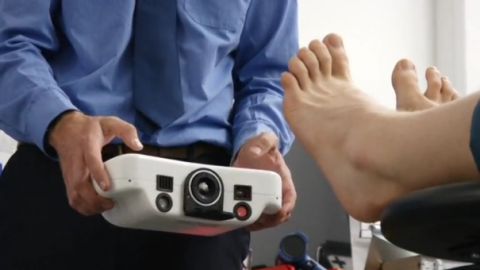
LONDON, United Kingdom (Reuters) — A foot-temperature monitoring system could help detect when diabetic patients are developing foot ulcers, a common complication that can lead to infections and amputations.
Diabetic foot ulcers typically develop on the bottom of the big toe or the ball of the foot, often when people wear ill-fitting shoes.
Patients with diabetes frequently have nerve damage that limits their ability to feel pain, and as a result they don’t notice developing ulcers.
“If you have an ulcer it may progress towards amputation,” said Robert Simpson, senior scientist at the National Physical Laboratory (NPL).
“Up to 50 percent of those who have an amputation are dead within two years, and up to 80 percent are dead within five years. So any early indication, any warning, any better management of the diabetic foot for pediatrists and diabetologists and for the patient themselves is critical.”
Skin temperature typically increases as ulcers develop.
Research funded by the National Institute for Health Research has helped develop a new medical imaging device, called DFIRST, which uses this temperature change – identifiable before visible signs – to give an early warning of ulceration.
Currently, doctors use single-spot devices to manually test across multiple areas of the patient’s foot to gather the data.
Not only is this labor-intensive, but also subjective as to where the clinician chooses to place the device on the patient’s foot.
With DFIRST, the whole foot can be heat mapped very quickly.
“You can take a snap-shot, an immediate snap-shot of a patient within a second. Their thermal profile provides you with an objective set of data with which you can make an on-going assessment in collaboration with the patient so you can better manage or better identify risk areas,” added Simpson.
Other studies have looked into monitoring foot temperature as a precursor to ulceration, including a study this year by researchers at Baylor College of Medicine in Houston who tested a so-called smart mat designed to use variations in temperature at different points on the foot as a predictor of recurring foot ulcers.
The prototype DFIRST device has been in clinical trials for two years, Simpson added.
It uses many off-the-shelf components – with the NPL developing the metrology and data analysis – making the technique low cost, as well as non-invasive.
Further clinical trials are on-going and the next version of the device will be reduced in size and weight.
Eventually, Simpson said they want a device that is as small and simple to use as a smart phone.
This could make the technology suitable for home use, giving patients the power to monitor risk throughout their life.
“There are 140 amputations every single week [in the UK], so that’s nearly one every hour, 80 percent of which are driven by foot problems,” Simpson said.
“Anything that we can do to better manage that and/or provide a life-change for them is just incredibly important for us to do.”







